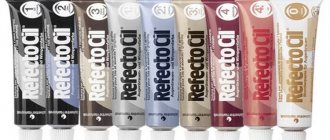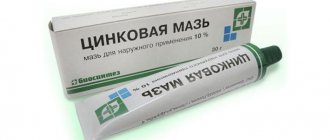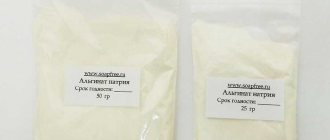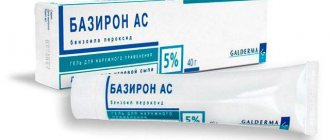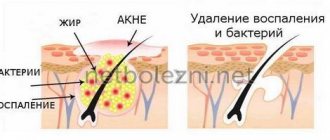General information
Retinol palmitate is a derivative of vitamin A and palmite salt. A fat-soluble substance that compensates for vitamin A deficiency in the body. The substance is not synthesized independently; it enters the body with food. The content in plant foods is lower than in animal foods. A shortage has serious consequences:
- premature aging of the skin, formation of wrinkles;
- the appearance of pimples, blackheads;
- increased susceptibility to infections;
- decreased reproduction;
- decreased functionality of the eye analyzer;
- increased fragility, hair loss;
- deterioration of tooth enamel;
- developmental delay in children.
Retinol based on palmite salt or ester is completely processed by the body. Unlike retinol acetate, synthesized using acetic acid. Manufacturers are different.
Retinol palmitate, oil solution 100000 IU/ml (10ml)
from 311 ₽
More details
| Active ingredient, name | Manufacturer, country |
| Retinola palmitate, retinol palmitate | ICN October, ICN October, Russia |
| Retinola palmitate, VitA-Pos | Ursapharm, Ursapharm Arzneimittel, Germany |
| Retinola palmitate, retinol palmitate | Marbiopharm, Marbiopharm, Russia |
Which is better - tretinoin or retinol oil solution?
According to Dr. Zeichner, the main difference between the two is the strength of the effect. Prescription retinols are a form of Retin-A (the original name of the drug tretinoin ), also known as tretinoic acid. Because this modification is a direct acid, it is considered the most powerful form of retinol.
The most common side effects of Retin-A include burning, redness, itching and flaking, and for this reason the drug is available by prescription only. As a rule, such prescriptions are given to patients suffering from deep, cystic or chronic acne, but the remedy can also be effective when it comes to mild acne.
On the other hand, an oil solution of retinol (retinol palmitate and retinol acetate), which is sold without a prescription, is one of the more gentle products than Retin-A. While prescription retinol is delivered to the skin through an acid, over-the-counter retinols are designed to come into contact with the skin so that enzymes can convert it into retinoic acid on their own.
Because the skin itself converts the ingredient, over-the-counter retinol is typically gentler on the skin and does not cause irritation, but it takes longer to show results.
This drug is not recommended for those who suffer from cystic acne, but is indicated for those who are looking for an effective form of anti-aging or want to find a remedy to combat mild forms of acne, as well as blackheads or closed comedones.
Composition and release form
The most common is as an oil solution.
The photo shows what the packaging of drops used for oral administration of retinol palmitate drops looks like. Palmitate is available in the form of an eye ointment. Indicated for topical use for eye diseases. What the drug looks like can be seen in the photo. The vitamin is available in capsules or tablets. You can see what they look like in the photo. Each capsule contains an oil solution. The composition of the drugs can be seen in the table presented.
| Release form | Amount of vitamin A | Additional composition |
| Oil solution | 100,000 IU per 1 ml. One drop contains 3300 IU. | Rapeseed oil, butylated hydroxytoluene, butylated hydroxyanisole. |
| Ophthalmic ointment | 250 me in 1 gram. | Vaseline, liquid paraffin, lanolin. |
| Capsules | 100,000 IU per 0.1 ml capsule. | Corn oil, gelatin, glycerol, nipagin, water. |
Pharmacy forms
Some retinol-based products are only available at the pharmacy.
Composition and release form
Retinol is available in the pharmacy in the following forms:
- Capsules. Contains vitamin A, additional substances (gelatin, glycerol, dye, methyl parahydroxybenzoate, hydrated soybean oil).
- Pills. 1 tablet contains 0.001135 g of vitamin A.
- Solution in ampoules for injection. Contains soybean oil and retinol.
- Serum with retinol 1%.
pharmachologic effect
Pharmaceutical preparations are used to normalize the concentration of vitamin A in the body.
Pharmacological properties of retinol:
- restorative;
- immunomodulatory;
- antioxidant;
- wound healing.
After starting administration, the maximum concentration of the component is reached after 5-6 days, only after which the positive effect on the body begins.
Indications for use
Retinol preparations are used for the following conditions:
- vitamin A deficiency;
- eye diseases;
- skin pathologies;
- rickets;
- collagenosis
Contraindications
Particular caution should be taken when using retinoids in any form during pregnancy and breastfeeding. People with sensitive skin and skin conditions should consult a specialist before use.
if contraindications and dosages are observed, preparations with vitamin A will have a positive effect
Side effects. Overdose and interaction
Long-term use or overdose of retinol medications can lead to side effects such as drowsiness, lethargy, blurred vision, headache, and irritability.
The most common side effect in cosmetology is skin irritation. The active ingredient exfoliates the skin, which can lead to increased sensitivity and irritation. The appearance of various imperfections on the skin may be a sign of an allergic reaction to the product. In this case, it is recommended to consult a dermatologist to determine whether use should be continued.
Before starting treatment, study what retinol (vitamin A) is, instructions for use, release forms, where the component is contained, side effects, contraindications, indications for use.
Terms of sale and storage. Best before date
Store the drugs in a dark place, out of reach of children, at a temperature above +8°C. The shelf life of products with retinol is 12 months. They are available by prescription.
Instructions for use of retinol. Method and dosage
The dosage depends on the patient’s condition and is determined by the doctor after examination. For mild vitamin deficiency, adults are prescribed up to 33,000 IU/day. For children, the doctor can prescribe 1000-5000 IU/day (depending on age and pathology). In severe conditions, adults may be prescribed 50,000-100,000 IU/day. The drugs are taken orally.
Pharmacological properties
The instructions for use of retinol palmitate preparations indicate the effect of oral administration.
Mechanism of action
In addition to replenishing the lack of vitamin A, it has a positive effect on:
- activation of redox cellular reactions;
- acceleration of cell division in the epithelial layers of the skin;
- prevention of keratinization of skin tissues above normal;
- provides energy for metabolic processes at the cellular level;
- strengthens the barrier role of cell membranes, which increases the body’s resistance to infectious diseases;
- a component of rhodopsin, which is responsible for twilight vision;
- enhances the hormonal activity of the adrenal glands;
- normalizes the functioning of sebaceous and sweat glands.
What happens after taking it
Retinol taken orally is completely absorbed in the intestinal tract. Most of it accumulates in the liver parenchyma. Lipocytes, specialized cells, are responsible for storage. In second place is the retina of the eye analyzer. It is present in small amounts in other organs. Excretion from the body occurs through bile, urine, and feces. It tends to accumulate due to the slow processing speed.
pharmachologic effect
Retinol acetate – what is it? Retinol acetate ( vitamin A ) is a fat-soluble vitamin that plays an important role in metabolism. It is necessary to stimulate the processes of regeneration and epithelization, maintain vision function, proper growth and development of the body, increase the body's resistance to adverse environmental conditions and improve the nonspecific immune response.
vitamin A deficiency due to poor nutrition and diseases of the liver and digestive tract.
Indications for use
The instructions for use indicate in what cases it is necessary to use retinol palmitate.
Pathologies of the visual analyzer
It is recommended to take medications both for the treatment of diseases caused by a lack of vitamin A, and for the complex treatment of diseases:
- dryness of the mucous membranes of the eyes;
- decreased vision at night;
- inflammation of the conjunctiva of the eye;
- dystrophic changes in the retina;
- progressive cataract;
- intense visual stress, wearing contact lenses, long periods of time at the computer;
- harmful effects of the environment - solar radiation, staying in a smoky room, under air conditioning.
Skin diseases
Vitamin A in the form of retinol palmitate is indicated for dryness, irritation, and lesions of the following nature:
- thermal effects on the skin;
- for ichthyosiform erythroderma - diseases in which large scales form in skin folds, hair, nails are characterized by accelerated growth;
- neurodermatitis - skin damage caused by allergic causes;
- keratoses - pathologies in which thickening of the epidermis occurs;
- psoriasis – scaly lichen, characterized by the formation of red spots that rise above the surface of the skin;
- acne, pimples on the face;
- excessive hair loss, baldness.
Pathological conditions of internal organs
The instructions stipulate the following cases when it is indicated to take supplements orally:
- ulcerative lesions of the gastrointestinal tract;
- infectious and colds of the upper respiratory tract.
Contraindications and precautions
Vitamin A in the form of retinol palmitate should not be taken in the following cases:
- pregnant women in the first trimester due to negative effects on the fetus;
- during the acute phase of inflammatory pathologies of the skin;
- excess vitamin A in the body;
- chronic pancreatic disease;
- individual intolerance;
- gallstones.
Use caution, only on the recommendation of a doctor, for pathologies:
- viral hepatitis, cirrhosis;
- alcoholism, including those caused by beer abuse;
- heart failure;
- kidney inflammation;
- children and elderly people.
Side effects
A systemic side effect of Retinol is hypervitaminosis A. In adults, it is manifested by lethargy, drowsiness, headache, nausea, vomiting, facial flushing (in some cases with peeling of the skin), pain in the bones of the lower extremities, gait disorders, exacerbation of liver diseases. Children may experience drowsiness, increased body temperature and intracranial pressure (in infants, protrusion of the fontanelle is sometimes observed and hydrocephalus develops), vomiting, increased sweating, and skin rashes. Most adverse reactions resolve with dose reduction or temporary discontinuation of the drug.
On the first day of using Retinol, some patients experience an itchy maculopapular rash. This symptom is a reason to discontinue the drug.
When taking vitamin A in high doses for skin diseases, after 7-10 days of treatment, an exacerbation of the local inflammatory reaction is often observed. It decreases with continued therapy and does not require additional treatment.
Possible local reactions with intramuscular injections are pain at the injection site and the formation of infiltrates.
When using Retinol externally, hyperemia and itching at the site of application are possible. If such symptoms appear, treatment should be temporarily stopped.
An overdose of retinol can lead to acute hypervitaminosis, manifested by severe headache, drowsiness, dizziness, visual disturbances, confusion, uncontrollable vomiting, severe dehydration, and profuse diarrhea. On the second day, a rash may appear throughout the body, followed by large-plate peeling, starting from the face. Another symptom is painful palpation of long tubular bones, which is explained by changes in soft tissues and bones, as well as subperiosteal hemorrhages. In children, acute hypervitaminosis manifests itself as excitement, anxiety and insomnia on the first day; in some cases, body temperature rises to 39 ºС, drowsiness appears, and vomiting occurs. The large fontanelle may protrude and signs of suffocation may appear. Treatment of overdose is symptomatic. Patients are prescribed ascorbic acid, and thyroxine as a retinol antagonist.
Features of dosage and methods of application
Vitamin A in the form of retinol palmitate is used as prescribed by a doctor; how many drops are needed for administration is calculated individually. Typically, supplements are taken once a day. It is recommended to take the drugs fifteen minutes after meals, late in the evening.
Supplements are prescribed in the form of drops:
- for the prevention and treatment of vitamin deficiency 33 thousand international units (10 drops);
- for the treatment of ophthalmological diseases from 50 to 100 thousand international units (0.5 -1.0 milliliter);
- for skin pathologies from 50,000 to 100,000 IU;
- therapy of acne, ichthyoform erythroderma - up to 300,000 IU.
An eye ointment containing retinol palmitate is placed under the lower eyelid. The strip is squeezed out to the size of one centimeter.
The vitamin in capsules is taken once a day, late in the evening, one tablet containing 100,000 IU.
Features of use for the face
Vitamin A is used in cosmetics for:
- getting rid of acne;
- obtaining a rejuvenating effect;
- reducing the number of fine wrinkles;
- alignment of the facial structure.
The substance is produced commercially in creams and masks. Retinol palmitate in the form of a solution is added to regular creams. There are known recipes for effective face masks made at home.
| Compound | Mode of application |
| Egg yolk, half a teaspoon of salt, 8 drops of retinol palmitate. | Mix and apply to face with a brush for three minutes. Used as a scrub. Effective against acne. |
| A tablespoon of cottage cheese and olive oil, 5 drops of vitamin A. | Prepare a homogeneous mixture, apply a layer of 2 millimeters for 20 minutes. |
| A teaspoon of dimexide, 50 grams of sour cream and white clay, 10 drops of vitamin. | Mix, apply a layer of five millimeters for 15 minutes. Effective against acne. |
Rules for using masks:
- It should be applied late in the evening, before bedtime - after the procedure, the skin is vulnerable to sunlight;
- applied to the face, neck, décolleté;
- up to 35 years of age, it is necessary to use retinol palmitate in the form of a solution, after that - in capsules;
- It is necessary to conduct an allergy test before use.
If anyone knows other recipes, please share your feedback.
Features of use for hair
Vitamin A is good for hair. Added to shampoos and masks. Application results:
- elasticity increases;
- shine increases;
- growth improves;
- the harmful effects of ultraviolet radiation are reduced;
- moisturizes the scalp.
A few milliliters are added to shampoos, and different recipes are used for masks.
| Compound | Mode of application |
| Dry collection of chamomile, nettle, horsetail, 10 grams each. Retinol – 4 capsules. Rye bread in the amount of 150 gr. | Prepare a decoction of herbs, leave for half an hour. Pour over bread, add capsules. The mass is rubbed into the roots and left for an hour under a cap. |
| Flax oil – 40 g., Eleutherococcus – 10 g., Retinol – 4 capsules. Egg yolk. | Mix the ingredients, apply to hair, distribute over the entire length. Leave for half an hour. |
To be effective, the mask should be used every other day.
Vitamin A is used to strengthen and grow eyelashes and eyebrows. The solution is applied to eyelashes and eyebrows with a small brush every night.
Features of use for pregnant and lactating women
How to take retinol palmitate preparations for pregnant women is decided by the gynecologist. The first trimester of pregnancy and breastfeeding are a contraindication . The rest of the time, women are recommended to have small maintenance doses of 5000 IU to avoid an overdose, which is more dangerous for the fetus than a deficiency.
Features of use for kidney pathologies
For nephritis, the use of the vitamin is not recommended. If an urgent need arises, how much supplement to take is decided by the attending physician, under the supervision of urine tests and biochemical blood parameters.
Features of use for liver pathologies
In case of viral hepatitis, cirrhosis, gallstones, the use of supplements must be agreed upon with a hepatologist.
Special conditions for children
Children under seven years of age should not be given vitamin A as a supplement. In conditions of vitamin deficiency, the pediatrician prescribes the use of the drug in a dosage of 5000 IU.
Elderly people
In old age, oral administration is dangerous; it is prescribed with caution, in a pediatric dose of 5000 IU.
Instructions for use of "Retinol Palmitate"
The drug should be used under the supervision of a specialist. The medicine must be taken orally after meals, late in the evening or early in the morning.
The instructions for Retinol Palmitate indicate the correct dosage of the drug. For minor vitamin deficiencies, the amount of medication should be up to 33,000 IU per day for an adult. In the case of defects of the visual system, such as retinitis pigmentosa, xerophthalmia, hemeralopia, the dosage can be increased to 10,000 IU. Children are recommended to take 2000-5000 IU throughout the day, taking into account their age.
If a patient uses “Retinol palmitate” for facial skin (general health and getting rid of pathologies), then the dosage should be in the range of 5000-10000 IU per day, and for children - twice as much.
Oil solutions can be used externally in case of burns, frostbite, ulcers, lubricating the damaged area 6-7 times throughout the day and covering with bandages. Together with them, the patient can use retinol intramuscularly or orally
The ointment should be applied in a thin layer to the injured areas twice during the day: morning and evening. If the patient's skin is very peeling, it is necessary to use an occlusive dressing. The duration of use of the drug can be from 4 to 12 weeks. The duration of therapy is determined by a specialist.
According to the instructions for use of Retinol Palmitate, a single dose of the medication should not exceed 50,000 IU for adult patients and 5,000 IU for children. The daily norm can be up to 100,000 IU and 20,000 IU, respectively.
To eliminate acne and ichthyosiform erythroderma in an adult, a dosage of the drug is used in the range of 100-300 thousand IU.
Overdose symptoms
If signs of vitamin A excess appear, you should stop taking the supplement and seek medical help. Symptoms:
- nausea, vomiting, epigastric pain;
- increased thirst;
- dry skin and mucous membranes;
- increased bleeding of gums;
- double vision, intolerance to bright light;
- frequent excessive urination;
- lethargy, irritability, sleep disturbance;
- the appearance of orange shades of the nasolabial triangle, the dorsum of the feet, and hands.
Reviews about the advantages and disadvantages
| Leave your review | |
| 1 2 3 4 5 | |
| Send Cancel | |
Send your review
Retinol palmitate
Average rating: Number of reviews: 0
Reviews of supplements with retinol palmitate are positive. They note affordable prices and easy portability. Most reviews about the high effectiveness of use in cosmetology. Among the disadvantages, a local inflammatory reaction is noted, which disappears after a few days.
Cost of supplements, where to buy
Retinol palmitate, oil solution 100000 IU/ml (10ml)
from 311 ₽
More details
Preparations containing palmitate can be purchased at pharmacy chains or online stores. The cost of supplements online is lower than in pharmacies. The oil solution will cost from 100 to 250 rubles, depending on the volume of the bottle. The cost of eye ointment is about 270 rubles. The capsule form is difficult to find on open sale.
Similar drugs
The following drugs are similar in their mechanism of action:
- Videstim - ointment for external use;
- Retinol acetate in oil - vitamin A based on acetic acid salts;
- Aevit - with the addition of tocopherol.
The unique properties of retinol supplements allow the substance to be used in many areas. External use avoids the risk of overdose, but the concentration in such cases is lower and the effect is slower. Ingestion should be supervised by attending physicians.
Watch the video about the benefits of vitamin A:

